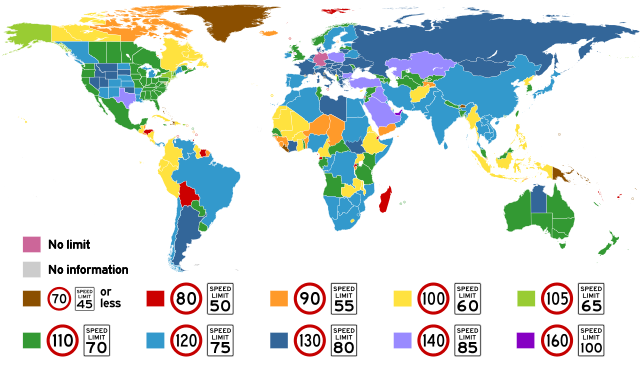Speed limit
maximum legal speed of vehicles From Wikipedia, the free encyclopedia
A speed limit is a legal limit on how fast a road vehicle can be driven. Some roads also have a minimum speed limit, which is how slow a vehicle is allowed to travel.

Reasons
Safety
Reducing speed reduces the number of accidents by giving more time to the driver to manage their vehicle. Reduces the consequences of an accident by reducing the energy involved in that crash.
Climate and environment
Because the emission of air pollutants increases disproportionately with increasing speed, speed limits are used to protect the climate and the environment. They are also used to reduce noise pollution.
Traffic flow
Minimizing the speed differences in traffic leads to more consistent speeds, which increases road capacity and reduces the risk of congestion. This improves the flow of traffic.
Due to the lower probability and severity of accidents, there are also fewer accident-related closures with a speed limit.
Driving situation
Speed limits are also used because they can create a more relaxed atmosphere for drivers.
Speed limits in different countries


Both
No speed limit units
In the UK, the speed limit in towns is usually 30 miles per hour, which is about 50 km/h, and the speed limit on dual carriageways and motorways is usually 70 miles per hour, which is about 105 km/h. In France, the speed limit on motorways is usually 130 kilometres per hour, which is about 80 miles per hour. Also, in the United States, most highways are from 65 to 70 miles per hour, and freeways are from 55 to 80 miles per hour. In Canada, the speed limit is usually about 100 km/h. In Australia the speed limit on freeways, highways and rural roads is between 100 and 130 kilometres per hour, and in towns and cities between 40 and 60 km/h but can go up to 90 km/h.
Nowadays, in the European Union, speed limits may vary from country to country or from region to region. Typical speed limits are 130 km/h or 120 km/h on rural motorways, between 80 and 100 km/h for rural roads, 70 km/h on point requiring a reduced speed, 50 km/h in main urban roads, and 30 km/h on residential urban areas.
Germany does not have a general speed limit for its motorways, but a recommended speed (Richtgeschwindigkeit) of 130 km/h. Sometimes, there are also variable or temporary speed limits.
However, most Germans want a speed limit.[1][2][3][4]
There are also many organizations that support a speed limit in Germany like Deutscher Verkehrssicherheitsrat,[5] Auto Club Europa,[6] Verkehrsclub Deutschland,[7] Deutsche Umwelthilfe,[8] Bund für Umwelt und Naturschutz Deutschland,[9] Greenpeace,[10] World Wide Fund for Nature,[11] Sachverständigenrat für Umweltfragen,[12] Wuppertal Institut für Klima, Umwelt, Energie gGmbH,[12] Gewerkschaft der Polizei,[13] Deutscher Ärztetag,[14] Umweltbundesamt[15] and Evangelische Kirche in Mitteldeutschland.[16]

Other websites
- Wikispeedia.org Archived 2015-03-27 at the Wayback Machine
References
Wikiwand - on
Seamless Wikipedia browsing. On steroids.
